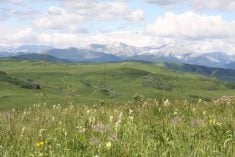BRANDON, Man. – A few years ago, Robert Krentz thought he had his niche in the cattle business all figured out.
Krentz, who runs about 6,700 acres near Grunthal, Man., had a large Simmental-Angus cow-calf operation, a good-sized feedlot and a booming business in selling replacement heifers in the fall.
“I had fat cows, I had pretty cows,” he told cattle producers from Manitoba and eastern Saskatchewan at a recent seminar. “But no one would pay me for the cows.”
So Krentz, known as an innovator, decided to start selling off his herd and putting up more fence.
Read Also

Gene editing digs deeper space in Canadian plant breeding
More Canadian research into crop variety development is incorporating gene editing, and one researcher notes that Canada’s regulatory approach to gene editing will help drive innovation
Krentz plans to use hogs to get more from the cattle business.
He produces about 950,000 pounds of beef per year. But in a few years, he said he thinks he’ll be producing about one million lb., on less feed, less machinery and at lower costs.
With hogs’ help
By next year, he’ll have 5,500 acres of forage in a rotational grazing system. He plans to buy 4,000 yearlings to harvest the grass, which he wants to grow with help from hog manure.
“I’ve been striving all my life to be a top-end breeder, and now I’m going to be a bottom-end buyer,” he said.
Krentz’s first contact with the hog industry came three years ago, when a neighbor building a hog barn asked to use his fields for spreading manure. Krentz said he was dubious, but after seeing the difference the free fertilizer made, he became more enthusiastic.
Now, he’s selling some land to operations run by Elite Swine Inc., a large hog production company, with 20-year lease-back agreements.
On one section the company is building 24 barns, each holding 3,000 piglets from 12 days of age to 50 lb.
The company will spread manure on the forage planted on the section, and on Krentz’s two adjoining quarters. Krentz also negotiated free electricity and water from the hog barns for his cattle.
Once the operation gets going, Krentz figures the section will be able to support 800 to 1,000 cattle on pasture. Each animal needs two tonnes of forage per acre for the summer.
There are no other neighbors near the operation, he said.
But he added his wife was upset about the prospect of having to close windows in their house for up to a week after manure spreading.
Friends and people in the community have had mixed reactions to his plans. But it’s attracting attention from Manitoba Agriculture officials grappling with the issue of manure management.
Even agriculture minister Harry Enns has been out to see what’s happening.
Krentz said there has been much negative talk surrounding the hog industry in the province, but he has found the positive. He said he feels hog manure could be the start of something big for the cattle industry.
“There are ideas out there that can work for different areas,” he said.














